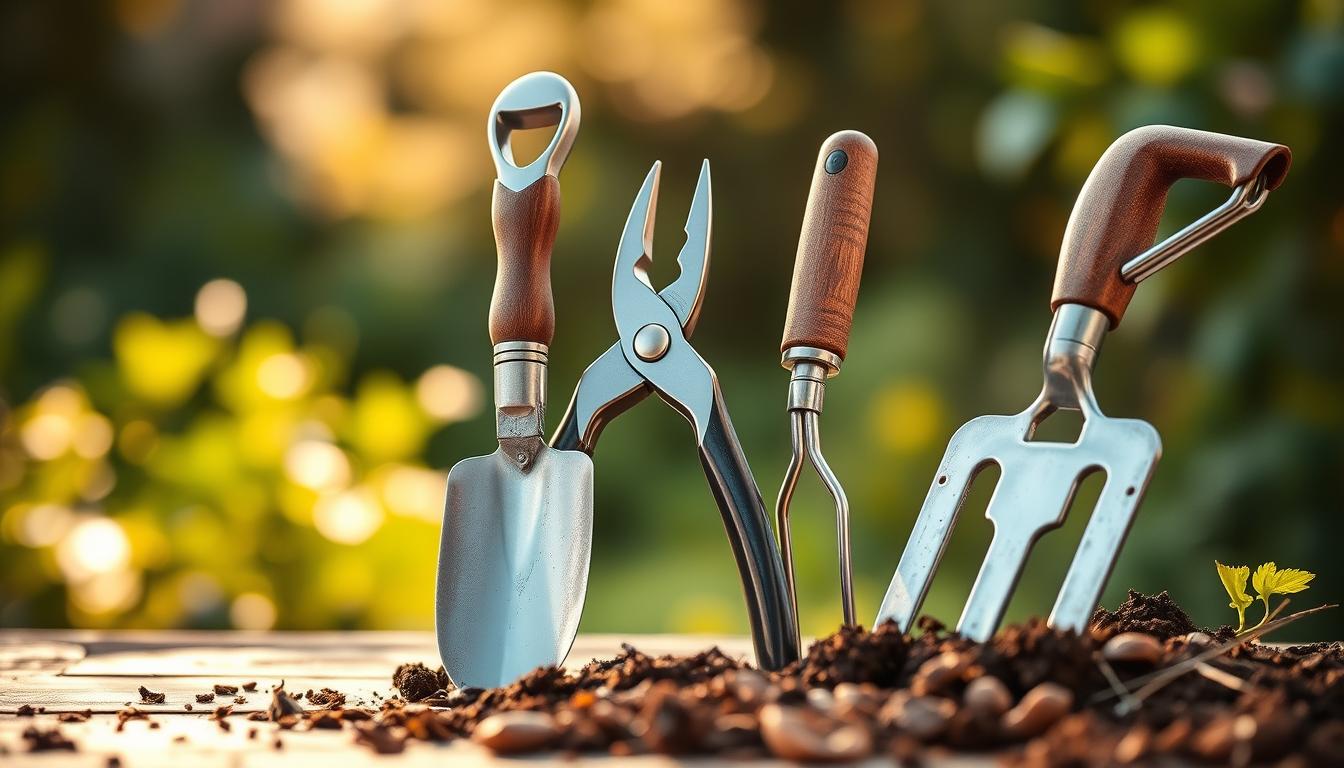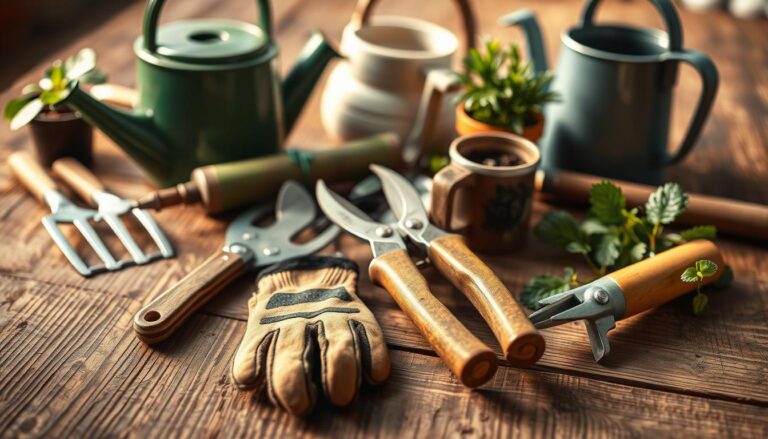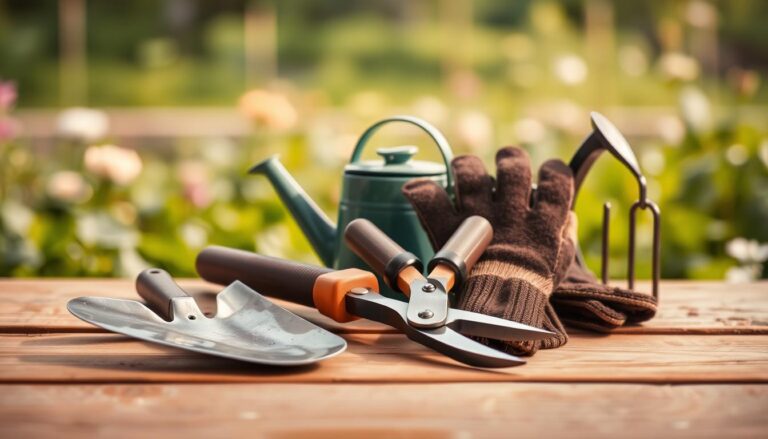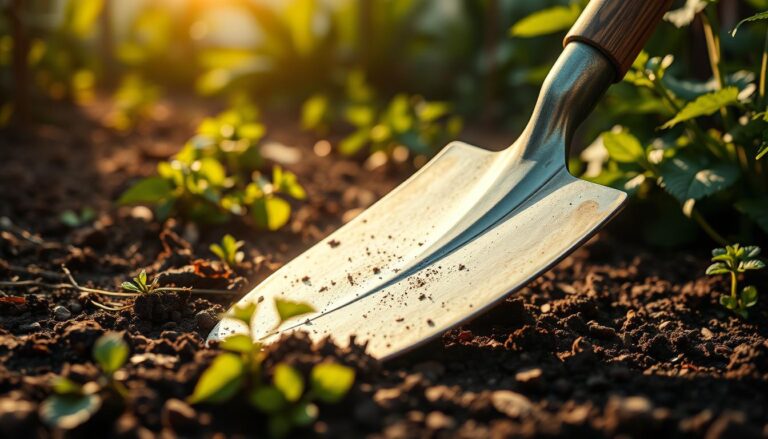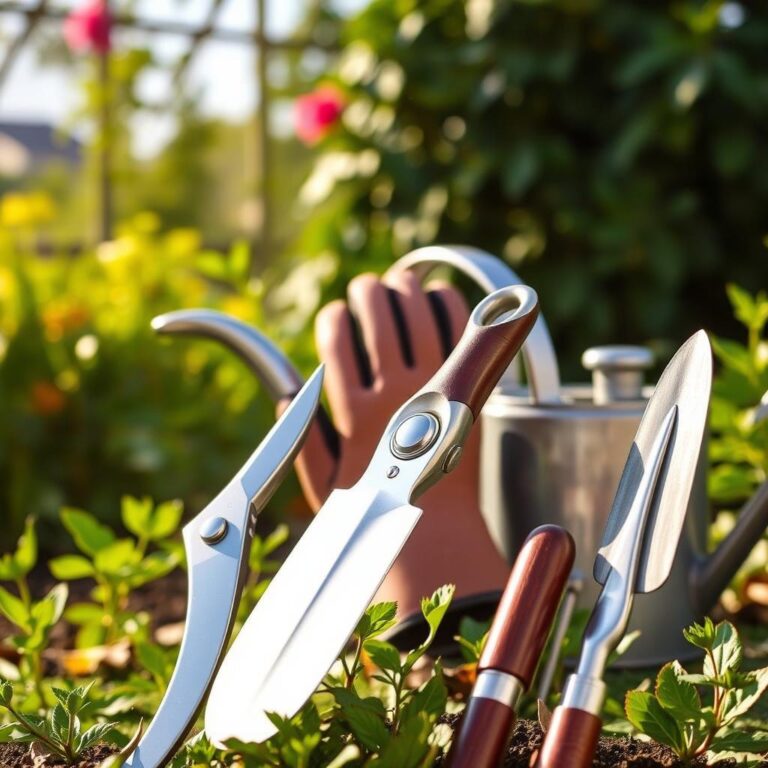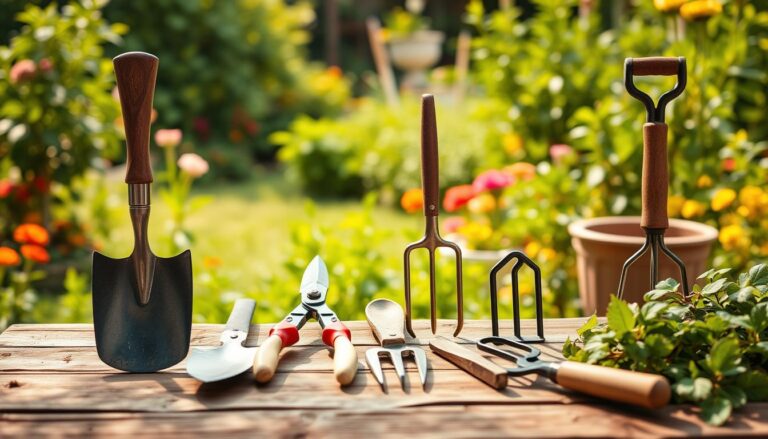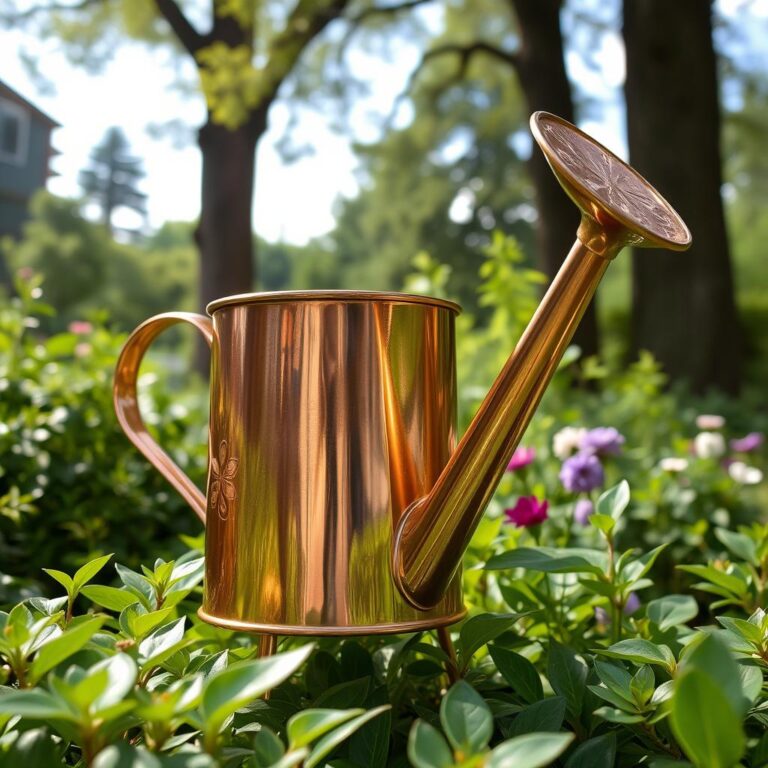Essential Tools for Gardening: A Complete Guide 2025
tools for gardening! Remember the last time you tried pruning overgrown shrubs with dull clippers or wrestled stubborn weeds using flimsy gloves? That frustration—the sore muscles, wasted time, and half-finished tasks—is why the right equipment matters. Whether you’re nurturing a backyard oasis or starting your first raised bed, the supplies you choose shape every moment spent outdoors.
Quality gear isn’t just about convenience. Ergonomic designs reduce strain on your joints, while durable materials ensure years of reliable service. Imagine trimming hedges with precision or planting seedlings without back pain. That’s the difference thoughtful choices make.
This guide simplifies everything: selecting ergonomic handles, organizing your shed, and maximizing efficiency. You’ll also discover how current promotions, like free shipping on select items, lower the barrier to upgrading your setup. No jargon, no overwhelm—just actionable insights to transform how you interact with your green space.
Table of Contents
Why Quality Tools Matter for Your Garden
Ever snapped a shovel handle mid-dig or watched rusted shears crush stems instead of slicing? Compromised equipment doesn’t just slow progress—it risks your plants’ vitality. Sharp, well-crafted items work with you, protecting delicate roots while tackling tough jobs efficiently.
Benefits of Using the Right Garden Tools
Precision matters. A polished blade makes clean cuts that heal faster, reducing disease entry points. Brands like Fiskars design pruners with non-slip grips and balanced weight, letting you trim branches without hand strain. These thoughtful details turn hours of work into comfortable, focused sessions.
Ergonomic handles also matter. Curved designs align with natural wrist movements, preventing blisters during repetitive tasks. You’ll pull weeds smoothly instead of yanking, preserving soil structure around nearby plants.
How Proper Tools Enhance Plant Health
Dull edges tear leaves, leaving ragged wounds that attract pests. Quality gear removes diseased growth cleanly, encouraging robust regrowth. For example, bypass pruners slice stems without crushing—vital for roses or fruit trees.
Strong rakes aerate soil without compacting it, while angled hoes sever weed roots below the surface. This precision keeps beds tidy and nutrient-rich. Your choices directly impact how plants access water, sunlight, and nutrients.
Must-Have Tools for Gardening
A well-equipped gardener moves through tasks like a chef with sharp knives—precision matters. Your green space thrives when matched with equipment designed for specific roles, from breaking ground to nurturing delicate seedlings.
An Overview of Essential Gardening Tools
Every thriving plot starts with core items. A sturdy spade slices through compacted earth, while a hand trowel’s narrow blade positions seeds at perfect depths.
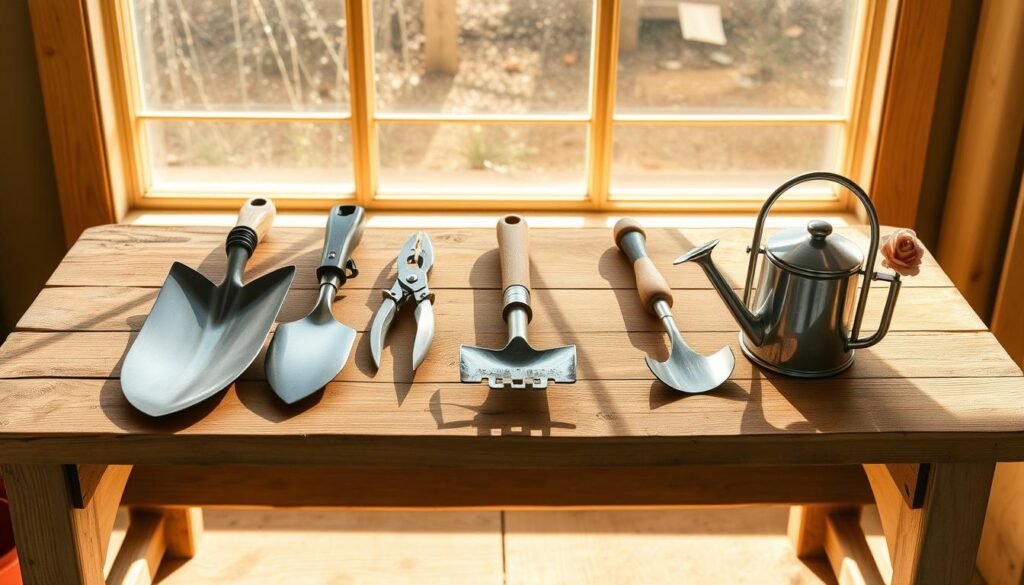
Versatility separates functional gear from garage clutter. Look for rust-resistant materials that withstand seasonal changes. Ergonomic grips on hoes and cultivators reduce fatigue during extended sessions. “Invest in multipurpose designs,” suggests veteran horticulturist Linda Chalker-Scott, “like a hori-hori knife that digs, measures depth, and cuts twine.”
Proper equipment simplifies routine care. A wheelbarrow hauls mulch efficiently, and a kneeling pad protects joints during transplanting. These choices directly impact your plants’ vitality—loose, aerated beds encourage strong root systems, while sharp edges prevent disease spread.
Cutting and Pruning Tools: Shape Your Garden
Have you ever admired a neighbor’s perfectly sculpted hedges or vibrant rose bushes? The secret lies in strategic trimming. Sharp, purpose-built gear transforms unruly growth into clean lines and thriving plants.
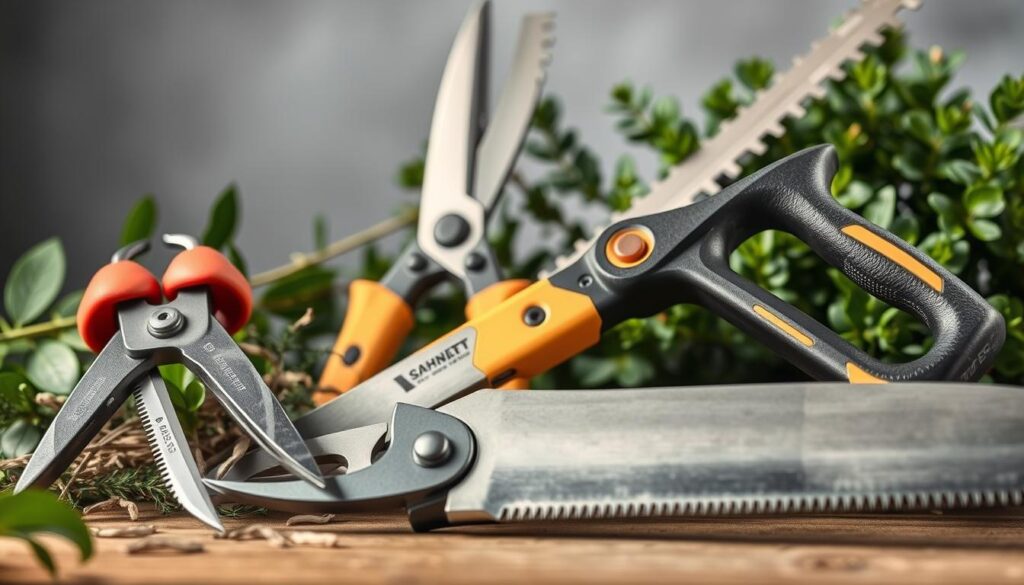
Precision matters most here. Clean slices heal faster, reducing disease risks. Crushed stems from dull edges invite pests. High-quality options like Hoselink’s designs combine surgical-grade blades with comfort-focused handles.
Handy Snippers for Precision Cuts
These compact heroes tackle delicate tasks. Their stainless steel blades glide through flower stems or herbs without bruising tissue. Non-slip grips let you maneuver around thorns or tight spaces safely.
Ideal for deadheading petunias or shaping boxwoods, they ensure minimal stress on plants. One gardener reported reviving her lavender bushes by switching to snippers that made angled cuts possible.
Ratchet Pruners for Tougher Branches
Thick rose canes or apple tree suckers demand more power. Ratchet mechanisms multiply your grip strength, tackling woody stems up to 1.5 inches thick. Squeeze once to start the cut, then release and squeeze again to finish.
This staggered action prevents hand fatigue. A California vineyard manager credits these pruners for reducing wrist strain during daily grapevine maintenance.
| Feature | Handy Snippers | Ratchet Pruners |
|---|---|---|
| Blade Type | Fine-edge stainless steel | Hardened carbon steel |
| Best For | Soft stems & detailed work | Woody branches up to 1.5″ |
| Ergonomic Benefit | Rotating grip reduces friction | 4-stage ratchet eases pressure |
Regular blade sharpening maintains peak performance. Wipe down after each use to prevent sap buildup. Your plants will reward you with vigorous growth and show-stopping beauty.
Planting Tools That Drive Growth
Ever tried squeezing tomato plants between balcony railings or starting herbs in cramped corners? Urban gardeners and small-space growers know: adaptability defines success. The right planting gear turns limitations into opportunities, whether you’re sowing seeds in fabric pots or dividing perennials in raised beds.
Heavy Duty Planter Bags for Versatile Planting
These fabric wonders transform patios, rooftops, and fire escapes into productive spaces. Made from breathable polypropylene, they prevent root rot by allowing excess water to drain while retaining moisture. UV-resistant materials withstand seasons of sun exposure without cracking or fading.
One gardener in Brooklyn grows zucchini vertically in planter bags hung from her fence. “They’re lightweight but sturdy,” she notes. “I move them to chase sunlight throughout the day.” Their collapsible design saves storage space when not in use.
Stainless Steel Hori Hori Knife: A Multi-Purpose Tool
This Japanese-inspired blade slices through soil like butter. Its serrated edge cuts stubborn roots, while the straight side measures planting depth. The ergonomic handle reduces wrist strain during prolonged use—perfect for dividing irises or planting bulbs.
“I’ve used mine to open bags of mulch, score tree bark for grafting, and even slice twine,” shares a Portland nursery owner. High-carbon stainless steel resists rust, maintaining sharpness through years of heavy use. Wipe it clean after each task to preserve its edge.
Gardening Maintenance Tools to Save Your Back
How many times have you stood up from weeding only to feel that familiar ache in your knees? Smart maintenance gear tackles this problem head-on, letting you nurture plants without sacrificing comfort. These innovations combine practicality with body-friendly designs to transform routine tasks.
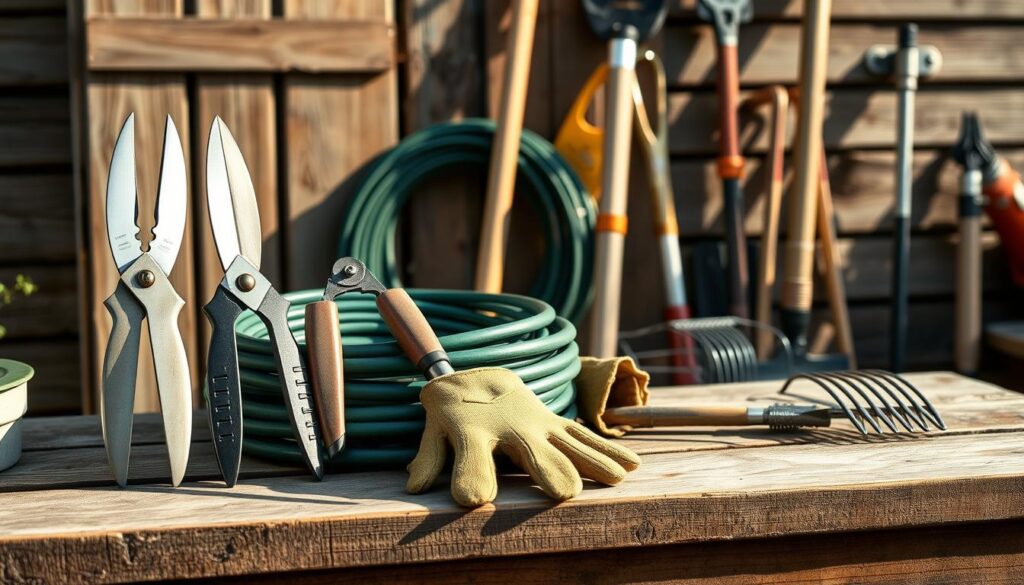
Garden Kneeler & Seat: Dual-Purpose Comfort
This foldable helper serves as both cushion and stool. Thick foam padding protects joints during planting, while the flip-side seat offers rest between tasks. Built-in handles provide leverage when standing—no awkward scrambling to rise.
One Maryland gardener reports: “I extended my potting time by 40 minutes thanks to the support.” The powder-coated steel frame holds up to 250 pounds, making it reliable for all body types. Store it upright to save space in sheds or garages.
Stand-Up Weed Puller: No More Bending
Say goodbye to crouching over dandelions. This claw-tipped tool grips weeds at the root when you step on its foot pedal. A simple lever motion yanks invaders from soil while you stand straight. No chemicals needed—just pure mechanical advantage.
Users praise how it removes taproots intact, preventing regrowth. The aluminum shaft weighs under 3 pounds, ideal for navigating tight spaces between plants. Pair it with a bucket to collect debris as you work.
| Feature | Kneeler & Seat | Weed Puller |
|---|---|---|
| Primary Use | Ground-level tasks | Upright weeding |
| Key Benefit | Reduces knee pressure | Eliminates back strain |
| Material | Steel frame with EVA foam | Anodized aluminum |
Rotate between these items based on your task list. Start mornings with the kneeler for transplanting seedlings, then switch to the weed puller after lunch. Your body will thank you at day’s end—and your plants will thrive from consistent care.
Specialized Yard Tools: Shovels, Rakes, and More
Picture this: you’re preparing a new flower bed, but your shovel bends against rocky soil while your neighbor’s slices through effortlessly. The right earth-moving gear turns grueling labor into purposeful progress. Matching your equipment to terrain and tasks ensures every motion counts.
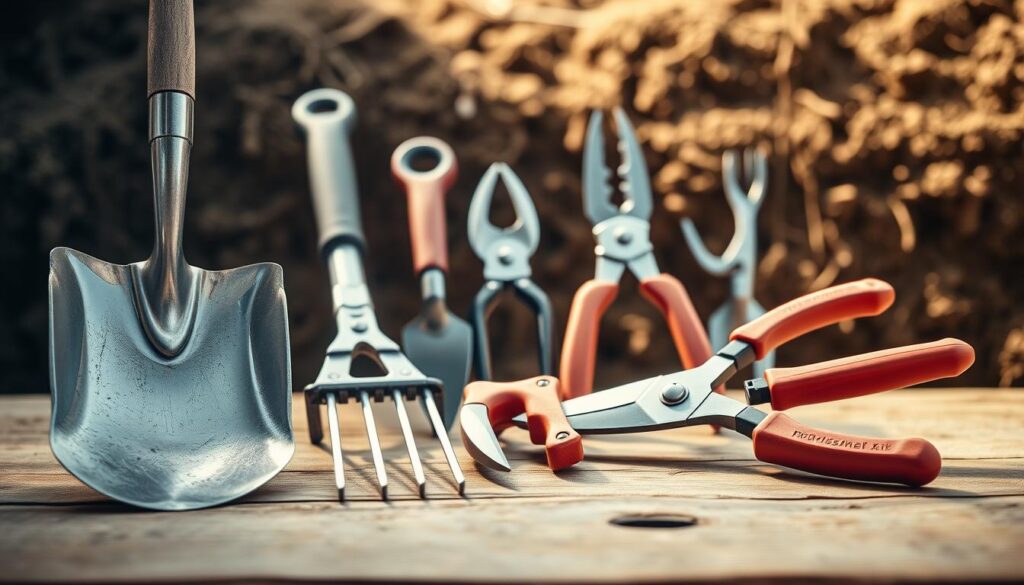
Spade vs. Shovel vs. Rake: What’s the Difference?
A spade’s flat, sharp edge slices through compacted ground, making it ideal for edging beds or digging trenches. Shovels feature curved blades to scoop mulch or soil efficiently. Rakes level soil or clear leaves—their flexible tines adapt to debris size.
Material quality dictates longevity. Stainless steel resists rust in damp climates, while carbon steel stays sharper longer. Oregon landscaper Marco Ruiz advises: “Spend extra on forged joints—they won’t snap when you hit hidden roots.”
| Tool | Best Use | Handle Type | Blade Material |
|---|---|---|---|
| Spade | Edging, precise digging | D-grip for control | Hardened steel |
| Shovel | Moving loose materials | Long straight handle | Aluminum alloy |
| Rake | Soil leveling, leaf clearing | Fiberglass shaft | Spring steel tines |
Ergonomic handles reduce wrist strain during repetitive motions. A fiberglass shovel handle absorbs vibration when breaking rocky ground. Pair tools to your space: narrow spades suit raised beds, while wide rakes maintain sprawling lawns.
Proper care extends their lifespan. Rinse soil off after use and hang vertically to prevent warping. Your garden thrives when each tool serves a distinct role—no more bent blades or aching shoulders.
Organizing and Storing Your Gardening Tools
Imagine opening your shed to find every item exactly where you need it—no frantic searches or misplaced pruners. Smart storage systems transform chaos into efficiency, protecting your gear from weather damage and extending its lifespan.
Wall-mounted racks keep frequently used items visible and accessible. Designate zones: hang cutting equipment on pegboards, store soil amendments in sealed bins near your garden bed, and place compost tools in a dedicated area to avoid cross-contamination. Metal hooks prevent handles from warping, while silica gel packs in storage boxes fight rust.
Short on space? Use vertical solutions. Install shelves above doorways for lightweight material like gloves or seed packets. Collapsible bins tuck under benches, and magnetic strips hold small metal items. One urban grower repurposed a shoe organizer to store seed markers and twine—“Every inch counts,” she notes.
Before storing, rinse off dirt and dry thoroughly. Apply linseed oil to wooden handles to prevent cracking. Sharpen blades monthly; a honing rod takes seconds but saves hours of frustration later. Organized spaces reduce trip hazards and let you focus on nurturing plants rather than hunting supplies.
Buyer’s Guide Insights: Budget and Durability Considerations
Have you ever bought a $20 shovel only to replace it twice in one season? Smart shoppers know: price tags lie. True value emerges when you weigh upfront costs against years of reliable service. Let’s break down how to spot quality without overspending.
Assessing Price Versus Quality
Cheap options tempt with instant savings but often fail under pressure. A plastic rake might handle light leaves but snap under wet debris. Compare handles—hollow aluminum bends, while solid steel absorbs stress. Look for reinforced joints and rust-proof coatings.
Mid-range picks balance affordability and durability. Fiberglass shafts flex without breaking, ideal for rocky yard soil. Brands like Corona offer lifetime warranties on pruners, signaling confidence in their materials. “Spend 30% more upfront to avoid 100% replacement costs later,” advises landscaper Tara Nguyen.
Long-Term Investment in Garden Equipment
Premium gear pays dividends through ergonomic designs and time savings. A $75 hori-hori knife outperforms three cheaper tools, reducing hand fatigue during all-day use. Stainless steel blades stay sharp for years, unlike carbon versions needing weekly honing.
Prioritize these features when funds are tight:
- Forged metal connections (not welded)
- Non-slip grips with contoured shapes
- Replaceable parts like pruner blades
Your garden thrives when you invest in the right tools—not the cheapest ones. Track seasonal sales for high-end items, and remember: quality grows value season after season.
Conclusion
What separates a thriving garden from a struggling one? Often, it’s the thoughtful selection of equipment you rely on daily. From precision cutting gear that protects plant health to ergonomic designs that spare your joints, every choice shapes your outdoor experience.
This guide highlighted essentials across five categories: shaping growth with clean-edged pruners, nurturing seedlings with adaptable planters, maintaining beds without strain, mastering terrain with specialized yard gear, and organizing supplies for efficiency. Each tool serves as an extension of your vision—durable, purpose-built, and designed to last.
Investing in quality pays dividends. Ergonomic handles reduce fatigue during marathon sessions, while rust-resistant materials withstand seasons of use. Combined with smart storage solutions, these items create a foundation for consistent care—and thriving plants.
Ready to elevate your green space? Explore curated selections offering free shipping, making premium gear more accessible than ever. Your garden deserves equipment that works as hard as you do—start building your ideal toolkit today.

